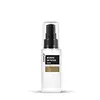What's inside
What's inside
 Key Ingredients
Key Ingredients

 Benefits
Benefits

 Concerns
Concerns

No concerns
 Ingredients Side-by-side
Ingredients Side-by-side

Centella Asiatica Extract
CleansingSh-Oligopeptide-1 13%
Skin ConditioningSh-Polypeptide-1 12%
Skin ConditioningGlycerin
HumectantBeta-Glucan
Skin ConditioningSodium Hyaluronate
HumectantSodium Acetylated Hyaluronate
HumectantHydrolyzed Hyaluronic Acid
HumectantAllantoin
Skin ConditioningBetaine
HumectantIllicium Verum Fruit Extract
PerfumingAmmonium Acryloyldimethyltaurate/Vp Copolymer
1,2-Hexanediol
Skin ConditioningButylene Glycol
HumectantCaprylyl Glycol
EmollientAdenosine
Skin ConditioningDisodium EDTA
Centella Asiatica Extract, Sh-Oligopeptide-1 13%, Sh-Polypeptide-1 12%, Glycerin, Beta-Glucan, Sodium Hyaluronate, Sodium Acetylated Hyaluronate, Hydrolyzed Hyaluronic Acid, Allantoin, Betaine, Illicium Verum Fruit Extract, Ammonium Acryloyldimethyltaurate/Vp Copolymer, 1,2-Hexanediol, Butylene Glycol, Caprylyl Glycol, Adenosine, Disodium EDTA
Water
Skin ConditioningButylene Glycol
HumectantGlycerin
HumectantAlcohol
AntimicrobialPropylene Glycol
HumectantNiacinamide
Smoothing1,2-Hexanediol
Skin ConditioningBetaine
HumectantGlyceryl Acrylate/Acrylic Acid Copolymer
HumectantPvm/Ma Copolymer
Emulsion StabilisingPEG/PPG-18/4 Copolymer
SolventAllantoin
Skin ConditioningTriethanolamine
BufferingAdenosine
Skin ConditioningLonicera Japonica Flower Extract
Skin ConditioningSolanum Lycopersicum Fruit Extract
AntioxidantLilium Tigrinum Extract
Skin ConditioningNelumbo Nucifera Flower Extract
Skin ConditioningChrysanthemum Indicum Flower Extract
Skin ConditioningHydrogenated Lecithin
EmulsifyingSh-Oligopeptide-1
Skin ConditioningCopper Tripeptide-1
Skin ConditioningHydrolyzed Collagen
EmollientAcanthopanax Senticosus Root Extract
Skin ConditioningPunica Granatum Extract
AstringentCarthamus Tinctorius Flower Extract
Skin ConditioningCarbomer
Emulsion StabilisingLeontopodium Alpinum Extract
Skin ConditioningThymus Vulgaris Extract
PerfumingMalva Sylvestris Flower Extract
Skin ConditioningBambusa Vulgaris Callus Culture Extract
Skin ConditioningSnail Secretion Filtrate
Skin ConditioningPhenoxyethanol
PreservativeEthylhexylglycerin
Skin ConditioningParfum
MaskingWater, Butylene Glycol, Glycerin, Alcohol, Propylene Glycol, Niacinamide, 1,2-Hexanediol, Betaine, Glyceryl Acrylate/Acrylic Acid Copolymer, Pvm/Ma Copolymer, PEG/PPG-18/4 Copolymer, Allantoin, Triethanolamine, Adenosine, Lonicera Japonica Flower Extract, Solanum Lycopersicum Fruit Extract, Lilium Tigrinum Extract, Nelumbo Nucifera Flower Extract, Chrysanthemum Indicum Flower Extract, Hydrogenated Lecithin, Sh-Oligopeptide-1, Copper Tripeptide-1, Hydrolyzed Collagen, Acanthopanax Senticosus Root Extract, Punica Granatum Extract, Carthamus Tinctorius Flower Extract, Carbomer, Leontopodium Alpinum Extract, Thymus Vulgaris Extract, Malva Sylvestris Flower Extract, Bambusa Vulgaris Callus Culture Extract, Snail Secretion Filtrate, Phenoxyethanol, Ethylhexylglycerin, Parfum
Ingredients Explained
These ingredients are found in both products.
Ingredients higher up in an ingredient list are typically present in a larger amount.
1,2-Hexanediol is a synthetic liquid and another multi-functional powerhouse.
It is a:
- Humectant, drawing moisture into the skin
- Emollient, helping to soften skin
- Solvent, dispersing and stabilizing formulas
- Preservative booster, enhancing the antimicrobial activity of other preservatives
Adenosine is in every living organism. It is one of four components in nucleic acids that helps store our DNA.
Adenosine has many benefits when used. These benefits include hydrating the skin, smoothing skin, and reducing wrinkles. Once applied, adenosine increases collagen production. It also helps with improving firmness and tissue repair.
Studies have found adenosine may also help with wound healing.
In skincare products, Adenosine is usually derived from yeast.
Learn more about AdenosineAllantoin is a soothing ingredient known for its protective and moisturizingg properties. Because of this, it is often added to products with strong active ingredients.
Studies show higher concentrations of this ingredient can promote wound healing.
Though it can be derived from the comfrey plant, allantoin is produced synthetically for cosmetic products to ensure purity.
Learn more about AllantoinBetaine is a common humectant (a substance that promotes retention of moisture). It's known to be gentle on the skin and can help balance hydration.
This ingredient is best for improving hydration and soothing irritated skin. Studies also show it helps even out skin tone.
Fun fact: Betaine is naturally created in the skin and body. The kind found within cosmetic products can be either plant-derived or synthetic.
Another name for betaine is trimethylglycine.
Learn more about BetaineButylene Glycol (or BG) is used within cosmetic products for a few different reasons:
Overall, Butylene Glycol is a safe and well-rounded ingredient that works well with other ingredients.
Though this ingredient works well with most skin types, some people with sensitive skin may experience a reaction such as allergic rashes, closed comedones, or itchiness.
Learn more about Butylene GlycolGlycerin is already naturally found in your skin. It helps moisturize and protect your skin.
A study from 2016 found glycerin to be more effective as a humectant than AHAs and hyaluronic acid.
As a humectant, it helps the skin stay hydrated by pulling moisture to your skin. The low molecular weight of glycerin allows it to pull moisture into the deeper layers of your skin.
Hydrated skin improves your skin barrier; Your skin barrier helps protect against irritants and bacteria.
Glycerin has also been found to have antimicrobial and antiviral properties. Due to these properties, glycerin is often used in wound and burn treatments.
In cosmetics, glycerin is usually derived from plants such as soybean or palm. However, it can also be sourced from animals, such as tallow or animal fat.
This ingredient is organic, colorless, odorless, and non-toxic.
Glycerin is the name for this ingredient in American English. British English uses Glycerol/Glycerine.
Learn more about Glycerinsh-Oligopeptide-1 is a peptide found naturally in our bodies. Peptides are the building blocks for collagen and elastin in our skin.
In cosmetics, this ingredient is bioengineered to be identical to a human gene that codes for epidermal growth factor (EGF). EGF are signal molecules that simulate cell growth and healing.
Studies find EGF help with:
In South Korea and China, EGF is considered a controversial ingredient. The South Korean Ministry of Food and Drug Safety has cracked down on companies with products including EGF due to false advertisement claims.
According to Dr. Zoe Draelos, growth factors have some drawbacks:
There is also controversy surrounding growth factors. The controversy is due to their mitogenic activity, or their ability to increase the number of cells. It is best to avoid using growth factors if you have psoriasis or are at risk of skin cancer. However, it should be noted EGF are not mutagenic - meaning they will not cause cancer.
Learn more about Sh-Oligopeptide-1